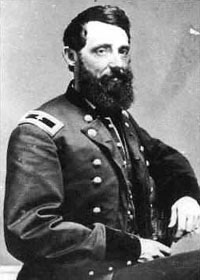 Life
Life
Benjamin Henry Grierson (1826-1911)
Brigadier General Benjamin Henry Grierson (July 8, 1826, Pittsburgh, Pennsylvania - August 31, 1911, Omena, Michigan) was an American army officer. He fought on the Union side of the American Civil War.
 Life
Life
Grierson was born in 1826, the youngest of five surviving children of Robert and Mary (Sheppard) Grierson. In 1829 the family moved to Youngstown, Ohio, where Benjamin attended common school. He became afraid of horses when at age eight he was kicked and nearly killed by a horse. In 1851, at age thirteen, he was chosen leader of the Youngstown band. In the 1850s he was a music teacher and band leader in Jacksonville, Illinois. On September 24, 1854, he married Alice Kirk of Youngstown. The couple had seven children, four of whom survived to adulthood. From 1855 to 1861 Grierson was a partner in an unsuccessful mercantile business in Meredosia, Illinois, and was active in Republican politics. Alice died August 14, 1888; Grierson later married Lillian Atwood King, a widow, July 28, 1897. During his life, he had homes in Jacksonville, Illinois, Fort Concho, and a summer home at Omena, Michigan. In 1907 he suffered a debilitating stroke; he died in 1911 and was buried in Jacksonville, Illinois.
Civil War
During the Civil War he rose from volunteer aide to major general of volunteers. He became a Northern hero when he led a spectacular cavalry raid ("Grierson's Raid") through Mississippi in May 1863. Before the end of the war he organized cavalry for a projected invasion of Texas and commanded the District of Northern Alabama.
Post Civil War
Colonel Grierson organized the Tenth United States Cavalry, one of two mounted regiments composed of black enlisted men and white officers.
After the war, as a colonel in the regular army, Grierson organized the Tenth United States Cavalry, one of two mounted regiments composed of black enlisted men and white officers.
He was commander at forts Riley and Gibson in 1867-69 and headed the District of the Indian Territory in 1868-69. He selected the site for Fort Sill, Oklahoma, and as commander (1869-72) supervised construction of the post.
His support of the peace policy on the Kiowa-Comanche Reservation angered residents of the Texas frontier. In May 1871 he arrested Indian chiefs Satanta, Satank, and Big Tree, who had led what became known as the Warren Wagontrain Raid in North Texas. At Fort Gibson in 1872 Grierson supervised the removal of intruders from the line of the Missouri, Kansas and Texas Railroad. He then spent two years as superintendent of the Mounted Recruiting Service at St. Louis.
In the spring of 1875 he arrived at Fort Concho, Texas. As commander of the District of the Pecos (1878-80), he explored and mapped the Trans-Pecos, constructed wagon roads and telegraph lines, and opened West Texas to settlement and the railroads.
During the summer of 1880 he defeated Victorio and ended the Indian threat to West Texas. In 1882 Grierson moved his headquarters to Fort Davis, where he greatly expanded the military facilities. He also invested heavily in land and organized a railroad-promotion company.
He commanded the Department of Texas in September and October 1883. During his military service in Texas, he and his wife came to love West Texas and planned to retire there.
Grierson was transferred in the spring of 1885 to Arizona, where he commanded Whipple Barracks and later Fort Grant. As commander of the District of New Mexico (1886-88), he dealt sympathetically and effectively with problems on the Jicarilla and Navajo reservations. In November 1888 he assumed command of the Department of Arizona.
He was promoted to brigadier general on April 5, 1890, and retired on July 8.
Alice Grierson died on August 14, 1888, and on July 28, 1897, Grierson married Lillian Atwood King, a widow. After the marriage, Grierson's trips between his Jacksonville, Illinois, home and his Fort Concho ranch, which he had visited regularly since his retirement, gradually stopped.
In 1907 he suffered a stroke from which he never fully recovered. He died at his summer home at Omena, Michigan, on August 31, 1911, and was buried at Jacksonville.